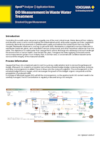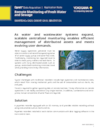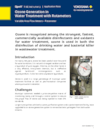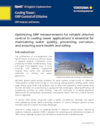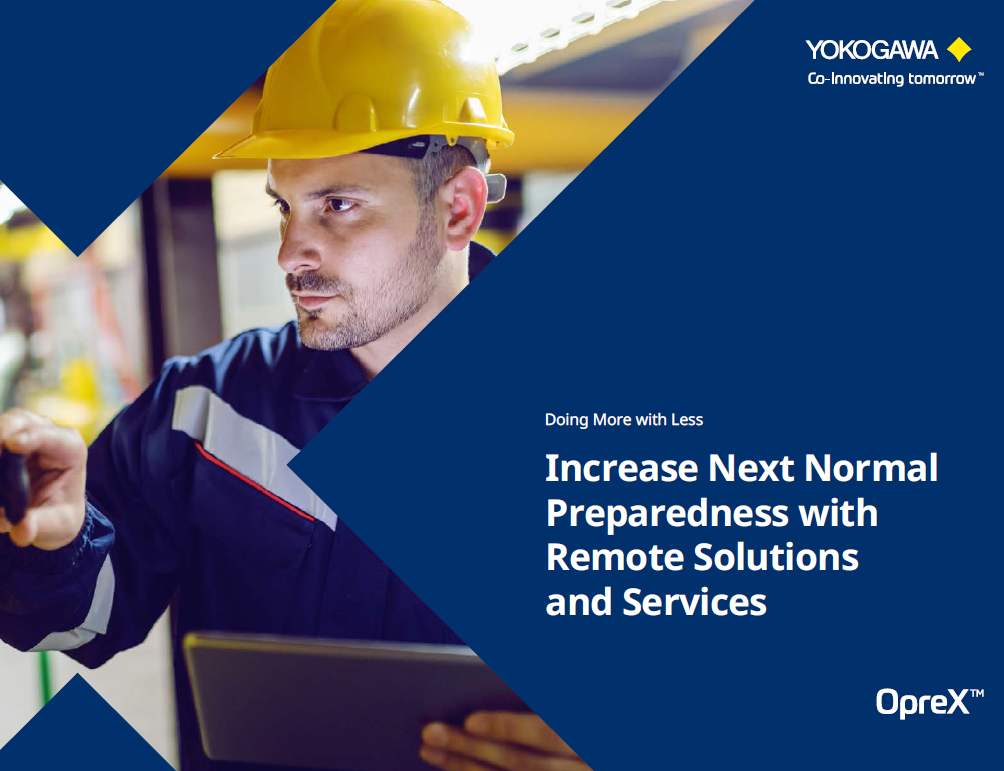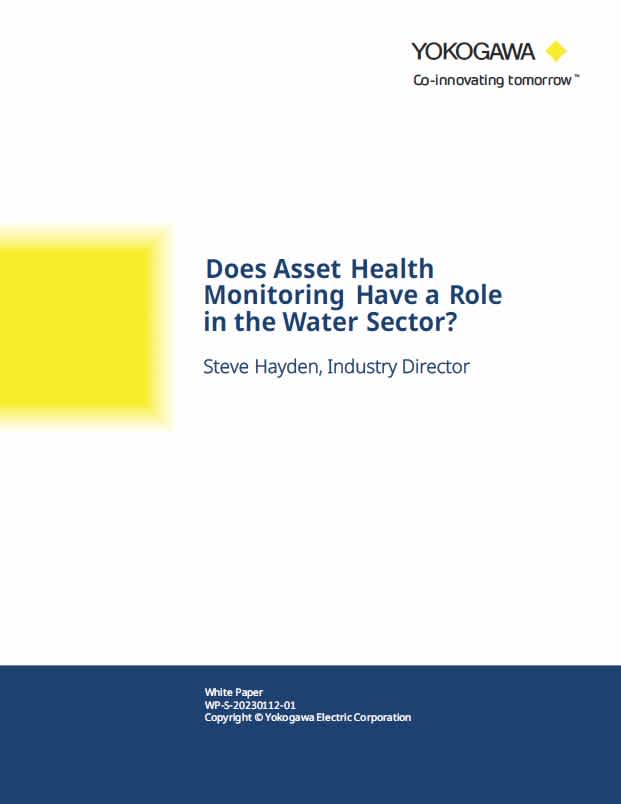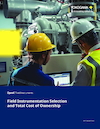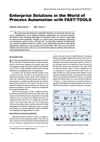Preserve Every Drop
All water, regardless of its source, has value. However, with finite water resources, a focus on "One Water" is necessary to maximize every drop within the water system, ensuring a stable supply of clean and safe water. As we consider current and future needs, planning and implementation are critical for long-term resilience and reliability, meeting both community and ecosystem demands. Yokogawa believes water is a human right for all. Thus, contributing to a sustainable water cycle is one of our Sustainable Development Goals (SDGs).
| Proud Sponsor of Our Blue World: We are Water Documentary |

Water & Wastewater Segments
-
Drinking Water Treatment
The goal of drinking water treatment is to produce clean, safe, and potable water that meets regulatory standards and is suitable for drinking and other domestic uses.
-
Industrial Water
Industrial water is essential for production and process water, manufacturing facilities, feed water for boilers and cooling towers, food & beverage processes, and other treatment needs.
-
Desalination
Desalination is the removal of dissolved salts from seawater, mineralized groundwater, brackish water from inland seas, and municipal wastewater.
-
Complete PFAS Management
Yokogawa offers a complete PFAS solution.
Upcoming Events
-
Event Mar 26 - Dec 31, 2025 CENTUM 50th Anniversary
Marking its 50th anniversary, CENTUM—introduced by Yokogawa in 1975 as the world’s first distributed control system—has continually advanced as a foundational platform for plant monitoring and control, renowned for its reliability, stability, and compatibility.
-
Conference Jun 9 - 11, 2025 Denver, COAWWA’S 2025 Annual Conference & Expo (ACE25)
Yokogawa is excited to attend the AWWA ACE25 Conference and Expo. Stop by and meet with our water experts to see how we can help transform the future of water through Yokogawa’s Industrial Automation, Sensing Products, and water demo in a live, hands-on setting.
-
Conference Sep 27 - Oct 1, 2025 Chicago, IllinoisWEFTEC 2025
Yokogawa is excited to attend WEFTEC’s 98th Annual Exhibition & Conference, the premier event where networks expand, ideas become solutions, and water quality innovation and expertise are on display.
Resources
The Metropolitan Cebu Water District (MCWD) needed to improve its water supply system to keep up with the growing demand.
Yokogawa installed field instruments at a total of 143 locations in MCWD’s water distribution network and a SCADA system with water leakage management software at the main office to reduce non-revenue water and improve stability of water supply.
The City of Eugene contracted Yokogawa for the challenging solution to enhance their control system with a secure wireless network to operate a wastewater treatment facility with a peak capacity of 277 million gallons daily using five processes.
- DDMO for the optimization of the air-blowing rate of the aeration tanks
- Interlink between DCS and DDMO to maximize the energy saving effect
RDR operates total 67km long race and supplies irrigation water to vast agricultural land in NZ's South Island.
FAST/TOOLS and STARDOM RTU were selected for management of the race and hydropower systems.
- More than 1,000 field devices designed to the PROFIBUS specifications installed in the state-of-the-art water reclamation plant.
- The high reliability and accuracy of our field devices contributes to the minimization of maintenance costs over the entire plant lifecycle.
- Innovative GEOLIDE waste water treatment complex in Marseille uses CENTUM and Exaquantum.
- The visualization of all data on items such as motor and pump operating time and chemical consumption amount allows operators to optimize key operation items.
Fish are totally dependent upon water to breathe, feed, grow, maintain a salt balance, and reproduce. Water quality determines the success or failure of an aquaculture operation.
As water and wastewater systems expand, scalable centralized monitoring enables efficient management of distributed assets and meets evolving user demands.
Yokogawa DPharp EJA/EJX Pressure transmitters do not need frequent re-zeroing due to superior long term stability, it contributes to reduce maintenance time.
Dairy wastewater is a mixture of organic compounds, suspended solids, fats, and bacteria that can produce a film or coating on equipment in the process.
Japan's Potable Water Quality Standard was fully revised in 2004, increasing the number of water quality standard items for which tests are required has increased to 50. As items necessary for water quality management, the authority has specified an additional 27 complementary parameters to set the targets for water quality management.
Ozone is recognized among the strongest, fastest, commercially available disinfectants and oxidants for water treatment, ozone is used in both the disinfection of drinking water and bacterial killer in wastewater treatment.
Optimizing ORP measurements for reliable chlorine control in cooling tower applications is essential for maintaining water quality, preventing corrosion, and ensuring work health and safety.
A Basic Guide to Accurate & Reliable Flow Measurement.
Optimizing four key factors will decrease pH sensor costs and optimize process control and overall plant efficiency.
In this Yokogawa RAP Best Practices eBook, you’ll discover how our wealth of knowledge about Integrated Safe Systems and Control of Work is available to help you and your teams design and implement a system that best suits your needs.
When selecting a Level Measurement device, what to consider in order to be accurate and repeatable?
Industrial process automation has evolved significantly over the years, playing a pivotal role in improving operational efficiency, safety, cost reductions, and ensuring product quality. Traditional automation systems, however, often relied on proprietary, closed architectures, leading to vendor lock-in, interoperability challenges, and limited adaptability to changing business needs often required for enterprises to expand or progress. Industrial process automation has evolved significantly over the years, playing a pivotal role in improving operational efficiency, safety, cost reductions, and ensuring product quality.
In this Whitepaper by Mark Hammer you will learn about:
- The movement away from proprietary, closed architectures
- How OPA avoids vendor lock-in and interoperability challenges
- Changing business needs requiring flexible systems to progress
By understanding what causes the difficulties in pH measurements and having the proper equipment, stable and accurate pure water pH measurement can be accomplished.
Asset health monitoring has long been in existence to protect expensive equipment and/or operations from costly, critical, or catastrophic failures, with numerous examples in nuclear, aeronautical, petrochemical, industries and beyond. The costs associated to install the sensors and asset health system way overcome the consequences of not implementing. However, this is not the case in all industries, with all equipment and/or all operations. In many cases equipment is run until failure and then repaired or replaced.
Yokogawa Electric Corporation, one of the leading manufacturers of industrial recorders, put the DAQSTATION DX series stations on the market in 1999, which added information processing and transmission functions to conventional recorders.
In recent years, more field wireless devices have been used in hazardous areas. Meanwhile, in plants that are usually recognized as hazardous areas, there are numerous metallic tanks and pipes that easily shield or reflect radio waves, as discussed later, thus resulting in a poor environment for wireless communication.
For large scale geographically dispersed projects, there may be a hierarchy of individual Process Automation systems, which in turn are each responsible for a specific region, and are managed by a higher level system. Engineering of systems on this scale is a huge challenge, because each individual system has its own database and its own configuration.
As compared to Distributed Control Systems (DCS) such as CENTUM VP that monitors the operations of the overall plant, PRM is a type of Plant Asset Management (PAM) software package that primarily focuses on the maintenance of devices and instruments.
In plant sites, there are various places such as those affording an unobstructed view like tank yards, and others surrounded by metal pipes and equipment obstructing the view (hereafter referred to "pipe jungles"), often seen in oil refinery and chemical on-site plants. The frequency band of radio waves used for field wireless communication is 2.4 GHz, which has high straightness and its ability to go around things can hardly be expected.
In recent years, expectations for control systems using wireless communications have been increasing in the process control market. This is because these systems do not require power and communication wiring for field instruments, enabling reduced initial and maintenance costs, and easy installation.
The introduction of wireless into industrial monitoring and control not only reduces wiring and maintenance costs but also expands its applications to include those which are impossible with wired systems, such as monitoring points which have to be given up due to the difficulty of the construction, and monitoring of points on rotating or frequently moved objects.
When it comes to digital transformation, Petronas’ Sharul Rashid wants to see more collaborative efforts.
For more YNOW2024 articles, please visit YNOW: A Yokogawa Users Conference | Control Global
ESG-focused institution offers a framework and a guide for manufacturers to be sustainable.
For more YNOW2024 articles, please visit YNOW: A Yokogawa Users Conference | Control Global
Is it a harmless duck or a venomous male platypus lurking in the bushes? Trish Kerin helps identify the biases that cloud our safety judgment.
For more YNOW2024 articles, please visit YNOW: A Yokogawa Users Conference | Control Global
View TechStar Blog
While cyberattacks and countermeasures are likely to evolve forever, there’s no reason the trip can’t prove successful and satisfying.
For more YNOW2024 articles, please visit YNOW: A Yokogawa Users Conference | Control Global
Downloads
Brochures
- Yokogawa Corporation of America Corporate Overview - Products & Solutions (3.5 MB)
- Yokogawa in the Water Industry in North America (1.8 MB)
- Differential Pressure Level Solutions (23.1 MB)
- Complete PFAS Management: Concentration and Destruction (3.1 MB)
- Liquid Analyzers in the Water Industry
- SENSTATION (492 KB)
- Overcome Temperature Effects for DP Level (778 KB)
- ROTAMASS TI Hygienic Series for Food and Beverage Solutions (5.8 MB)
Certificates
Videos
For more details, visit "www.yokogawa.com/CL-TB/"
Introducing Foam ARISe, our cutting-edge foam fractionation technology designed to remove PFAS from contaminated water, offering a targeted solution to mitigate environmental impact and safeguard public health, with a compact design for minimal footprint and ease of establishment.
Smart Water Management Systems provide clean and safe water.
Yokogawa provides a total water management system including Turbidity and Free Chlorine measurement.
Learn how Flow Imaging Microscopy is transforming a variety of aquatic fields, including Drinking Water Monitoring, Oceanography, Algae Cultivation, and Aquaculture.
The water and wastewater works around the world have to respond to a wide range of challenges.
Here we introduce Yokogawa‘s three initiatives to address these issues and challenges.
Our experts review the theory behind flow measurement technologies. Discuss common flow application challenges and evaluate the different technologies when selecting a flow meter. They also give examples of best installation practices for successful measurements.
Discover how to achieve industrial autonomy step by step through one of the 75+ inspiring presentations.
News
-
Press Release Nov 14, 2024 Yokogawa and Rice WaTER Institute Partner on Autonomous Water Treatment
-
Press Release Oct 28, 2024 Yokogawa Enters into Sales Partnership with Sensyn Robotics for Drone-Related Services
- For safe and efficient inspections of plants and other infrastructure all over the world -
-
News Brief Dec 15, 2022 CDP Recognizes Yokogawa with a Prestigious 'A' Score for Initiatives and Transparency on Water Security for the Third Time
-
Press Release Mar 25, 2022 Yokogawa Successfully Completes Proof of Concept for Optimization of Operations at US Wastewater Reclamation Facility Producing Potable Water
- Project receives Transformational Innovation award from the WateReuse Association -
-
Press Release Oct 28, 2019 Yokogawa Awarded Plant Simulation Project by PUB, Singapore's National Water Agency
Looking for more information on our people, technology and solutions?
Contact Us










